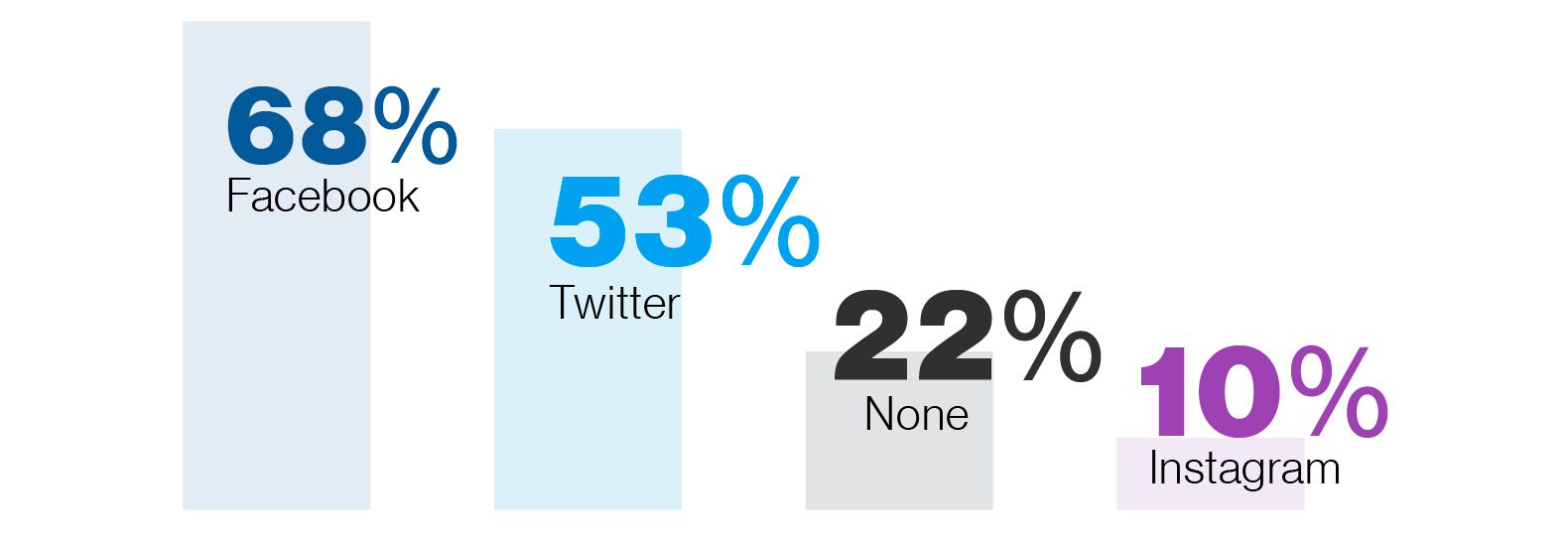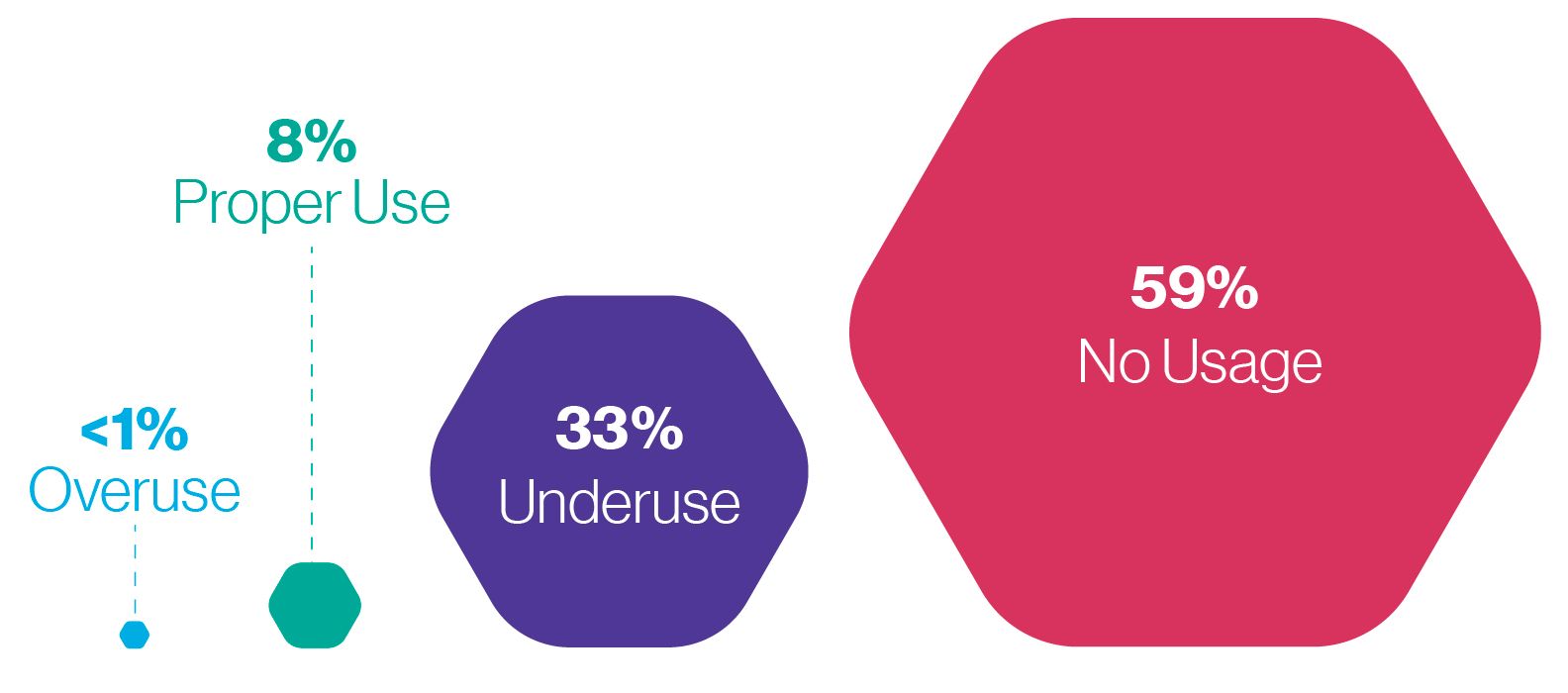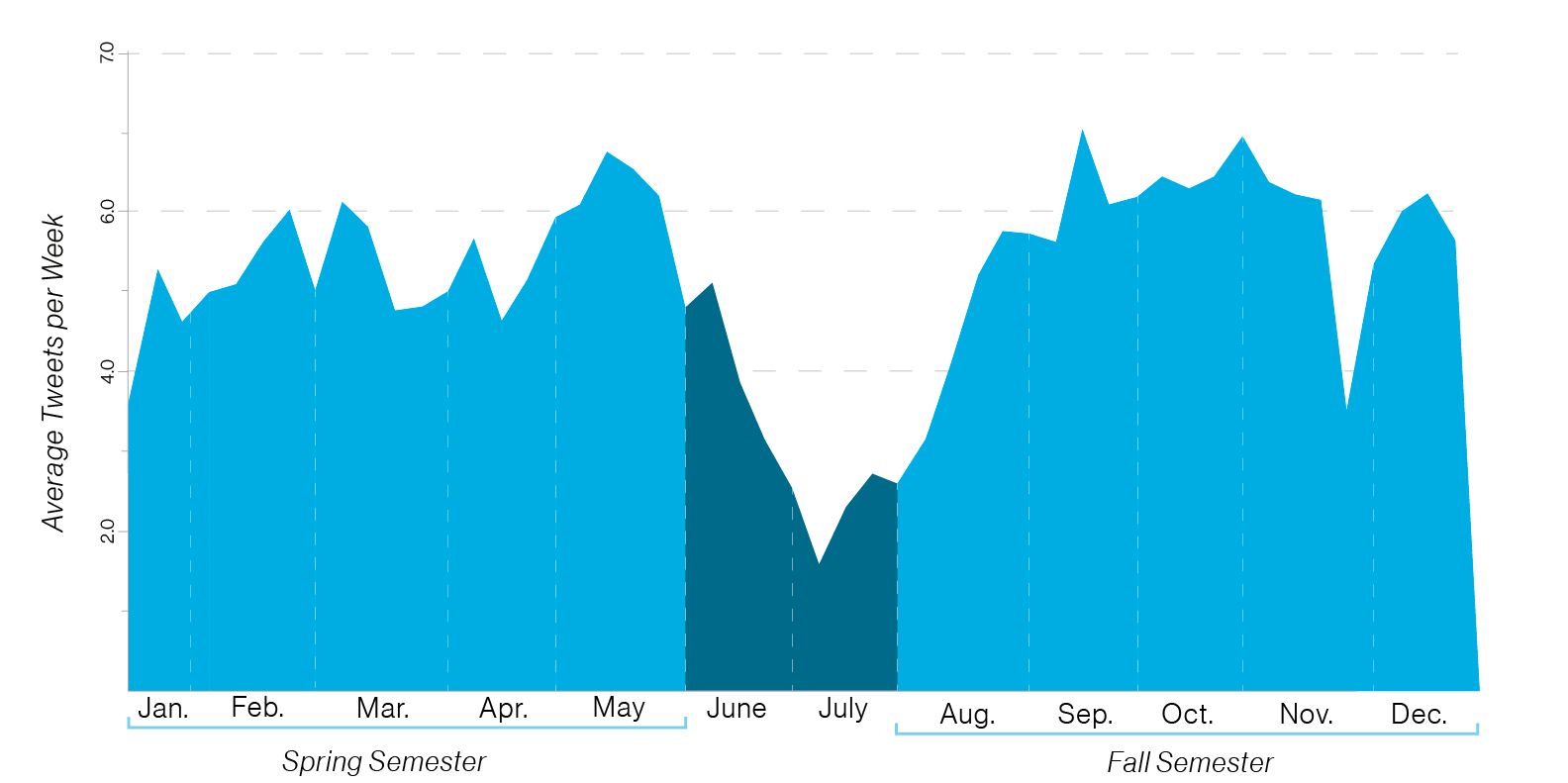The Disconnect
Just how big of an impact is social media making in school districts?

Schools aren't getting results from social media, which could be an opportunity for you.
Social media is often described as a one-stop shop for community engagement. The narrative painted for school administrators in conferences, news articles, blog posts, and professional development sessions is that social media can build a school’s brand and transform their relationship with the community. The reality is that school leaders were hired to run schools, not social media accounts. Making the transition onto Twitter and Facebook can be awkward at best, especially when running a Facebook page pulls administrators away from time in schools.
As marketers from the private sector, we see how businesses across industries are using social media to win and retain customers. New companies that scale quickly often do so by leveraging social media platforms to their advantage; it’s one of the most affordable ways to engage with a large audience. It seemed obvious that schools that are savvy enough to be on social would also be good at marketing themselves to parents. We set out to see just how big of an impact social media is making in school districts.
Does having a social media presence boost enrollment?
To answer this question empirically, we analyzed two states: California and Michigan. Both states are known for having a wide array of school choice programs, meaning that their schools are familiar with competition. Each state's Department of Education also share detailed records of how districts are gaining or losing students to school choice programs.
We recorded whether or not each district had an account on Facebook, Instagram, and Twitter, expecting to find that schools who were on social media would be attracting more students than those that were not. As it turned out, there was no statistically significant connection.
In sifting through hundreds of school profiles, we noticed that many schools only posted a few times a year. We wanted to see if this trend held true across the board, so we calculated the number of posts per district, then compared those numbers with the district’s gains in students. The result was the same: no significant correlation.
Brands in the private sector are using social media to grow into billion-dollar companies. What is the difference between how social media is used in schools versus private sector companies? Does the old saying, “It’s not what you say, it’s how you say it,” apply to schools and social media? To find out, we expanded our research to 1,000 schools from across the country. After accumulating data on the types of platforms each district used in 2017, we focused specifically on the way each school was using each platform: where were they posting, when were they posting, and what were they saying?
What we found is that industry best-practices that drive results in the private sector marketing world are not being applied in schools. There are a few basic adjustments that schools can make to their online presence to improve their marketing efforts. We’ll go through three key disconnects — and explain how schools can fill those gaps.
Click on a section to jump right to it!
- Disconnect #1: Schools don't show up.
- Disconnect #2: Schools aren't consistent.
- Disconnect #3: Schools miss opportunities to build their brands.
- Their loss can be your gain.
Disconnect #1: Schools don’t show up.
Before looking at the ways in which districts are using social media, we wanted to find out which platforms schools are using most frequently to communicate. What we found surprised us: one in five districts did not have a social media presence at all, let alone consistent usage. We’ll go through the three main social networks, examining the usage on each one.
Percentage of Districts on Each Platform

Approximately 32% of schools didn't have a Facebook page in 2017. When you consider the number of adults — families, teachers, parents, and community members — who are logging onto Facebook every day, it comes as a surprise that almost a third of schools aren’t utilizing the most common social media platform.
The Pew Research Center reported that 68% of American adults are on Facebook, and three-quarters of them check the platform every day. As a reference, around 100 million Americans watched the Super Bowl in 2018, which boils down to about one in three Americans. It’s as if the Super Bowl were happening twice a day on your community's phones, but almost a third of schools aren’t even joining the conversation. Facebook is a great community building tool, but we weren’t noticing much interaction on the vast majority of school pages.
That being said, schools use Facebook more than any other social network. The company has even started to gear their networking site towards schools specifically; they’ve built page and group templates that are designed to meet the unique needs of educational organizations. Districts have an opportunity to utilize these resources not just for marketing, but as educational tools in the classroom.
School districts use Twitter less frequently than Facebook; only 53% of schools had a Twitter account. Twitter has a significantly smaller audience base than Facebook overall. Pew Research reports that 24% of U.S. adults used Twitter in 2018, which is less than half of the adults on Facebook. Looking at these numbers, Twitter might not seem as valuable as Facebook simply because there are fewer people logging on. However, the two platforms are used in fundamentally different ways. As we have seen in recent years (just think of the 2016 election) Twitter can be hugely important in shaping political and media narratives.
Journalists, politicians, and everyday community members are logging onto Twitter to post about trends and hot topics, especially as they relate to political activity. Every member of the U.S. Senate and 98% of the House of Representatives have Twitter accounts. A survey from Muck Rack, a journalism analytics company, showed that 70% of journalists actively use Twitter. Ignoring the platform means missing out on a critical networking space. When rolling out new policies, sharing press releases, and thanking community volunteers, Twitter becomes a high-value platform for professional communication.
Instagram ranks dead last in terms of school districts’ usage. Less than 10% of districts are on the platform. This is probably due to the fact that Instagram’s user demographics slant towards millennials and teenagers, while most schools are run by the young at heart and wealthy in age.
The problem with ignoring the platform is that it’s widely used by a younger demographic — your students, parents, and teachers. Pew’s research finds that 64% of 18–29 year-olds are Instagram users. A study by the Associated Press found that 76% of 13–17 year-olds are active users. All the while, Facebook usage is shrinking in these groups.
A tactic used by many technology companies is to post about their company culture on Instagram as a recruiting tool. Instagram gives candidates a window into the workplace environment; companies celebrate their employees, show off their quirks, and highlight the best parts of the job. For schools, this is especially relevant because teachers are posting about their curriculum, their classrooms, even their new Jupiter-shaped earrings on Instagram. The platform has become an informal professional community, a great place for teachers to learn from one another. This creates an opportunity for schools to directly engage with the best teachers in their area.
At the same time, parents who are about to enroll their five-year-olds are in the core demographic of Instagram users. Posting about your most innovative teachers, spirit week, handwritten notes from students — anything that uniquely showcases the experience of working at and attending your school — can make a great first impression.
In this article, we won’t be focusing on Snapchat or LinkedIn. While they do have larger user bases, they aren’t really appropriate for school messages. Snapchat’s messages disappear after 24 hours, making the platform less useful for schools. LinkedIn is built for professionals, and is not seen as a major news source like Facebook or Twitter. While they can be powerful ways to connect, they are not a core platform that schools would be expected to use.
Disconnect #2: Schools aren't consistent.
The problem with the way most districts are using social media is a lack of consistency. The majority of districts aren't posting at all, many are sharing with seemingly little rhyme or reason, and a few are overwhelming their audience with minute-by-minute updates.
Instead of training customers to look to their social media for information, many school leaders act reactively to social media. They think that they have to bend to the world. The reality is that you can bend the world to you by consistently sharing information that’s relevant to your followers through the channels where you feel the most in control.
Districts' Twitter Usage in 2017

To understand the frequency of school social media posts, we focused on Twitter, which provides rich data about the timing and quantity of users’ posts. The standard in private sector marketing is to post to Twitter 3-5 times a day for large brands, and 2-3 times a day for smaller brands. This would mean that a school that is properly using the platform is Tweeting between 730 and 1,095 times a year. We found that only a small fraction of schools, about 8%, hit these targets. Most were nowhere close.
Our other major finding on consistency is that schools’ Twitter usage corresponds directly with the school year. We see districts full of energy at the beginning of the year, taking a break around Thanksgiving, posting sporadically during the spring, and ignoring their Twitter page during summer break.
Average Tweets by Week in 2017

It makes sense that districts would post less when students aren’t on campus. Unfortunately, the times when schools go on break are often the same times that parents are making choices about where to enroll their child. Schools need to find a way to maintain their social presence when school is not in session. This can be as simple as saving certain photos and stories to post in the future, creating a bank of posts available throughout the year.
A personal note from the editor about consistency: For three years, I lived in downtown Little Rock. Down the street from me was a local brewery that would frequently host different food trucks on their patio. This was great for me; it was like having a different restaurant opening up down the street from me every night. They would post which food truck would be on the patio to their Twitter page in the afternoon, and every evening I would pull out my phone to see what was for dinner. In a way, they trained me like a puppy. I wanted some information, they told me where it was, so I learned to check the communication channel they presented. Enough about my eating habits.
Disconnect #3: Schools miss opportunities to build their brands.
In the private sector, every post is crafted to spread the company’s brand. Think of Nike — each photo or poster is paired with #justdoit. When schools are posting, on the other hand, they’re not doing it in a way that spreads their messaging.
To better understand schools’ social usage, we again looked to Twitter. We reviewed the posts of 1,000 school districts across the country. After downloading 127,447 Tweets from 2017, we pulled out a sample set and then coded each Tweet by category.
In some ways, the results are encouraging. When we coded the Tweets to find positive posts (stories of student achievement, event invitations, and congratulatory messages), neutral posts (administrative updates), and negative posts (posts responding to a negative event or engaging in confrontation), we found that 78% of the posts were positive.
We further broke the Tweets down into categories based on similar themes. The largest category of posts were stories of the great things happening in each school, which is an excellent use of the platform. It’s clear that school districts see the power of sharing student stories.
Tweets by Content Category
Number of Tweets by Sentiment

However, we see that schools aren’t being strategic about linking stories to the school’s brand. We found that only 6.5% of the Tweets linked to a statement about the school’s messaging.
For example, let’s say your school’s motto is “learning through grit.” An unbranded
story would be, “100% of students in Mr. Steven’s AP biology classes scored a 4 or 5 on the AP test this year. Congrats!” A branded Tweet would be, “100% of students in Mr. Steven’s AP biology classes scored a 4 or 5 on the AP test this year. This is how Cougars learn through grit.”
That last part, “Cougars learn through grit,” shares the school’s messaging, which ultimately communicates the ways in which the district is unique. The biggest
goal of any branding campaign is to differentiate your product. By linking student stories to the school’s brand, your audience gets a clearer picture of the unique experience of attending the districts’ schools. If you want social media to make an impact, it’s critical to write posts that tie your school district to a set of ideas you’re hoping to impress upon your community.
Their loss can be your gain.
In any marketing effort, your goal is to differentiate yourself from everyone else. Because the education market is so far behind other sectors in social media, it’s easy for schools to get a leg up on the competition.
Getting started with social media marketing doesn’t have to mean devoting hours to finding the best photos and statuses to post about the school. Making the effort to plan in advance and share stories on the go—taking a little bit of time to focus on your school’s reputation—can transform your district’s online presence. Many superintendents take the plunge into social by capturing great stories in their district right when they see them. Whether a student is helping a friend with their homework or breaking a record in the swimming pool, taking note of a positive moment and sharing it online builds rapport with your community.
The key to developing a great reputation online is finding the positivity in your schools and sharing those stories. A small effort can go a long way on social media. The more the community can get to know your schools, the stronger your schools’ relationship with the community. From seeing how effective social media can be in the private sector, we know that social platforms can be a major tool to build your school’s identity.

SchoolCEO is free for K-12 school leaders. Subscribe below to stay connected with us!

